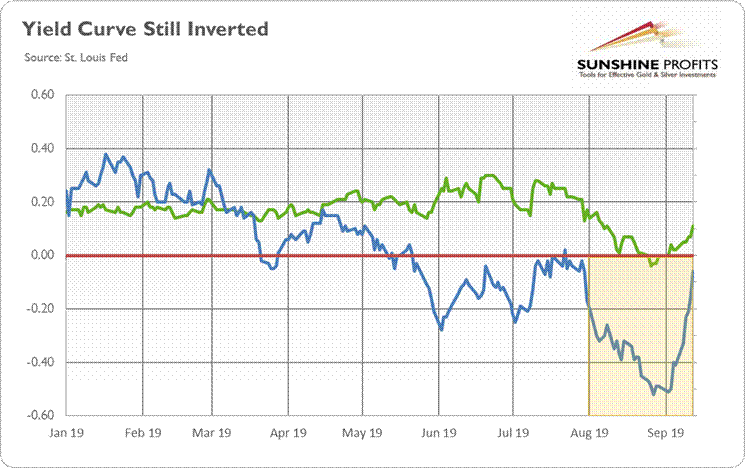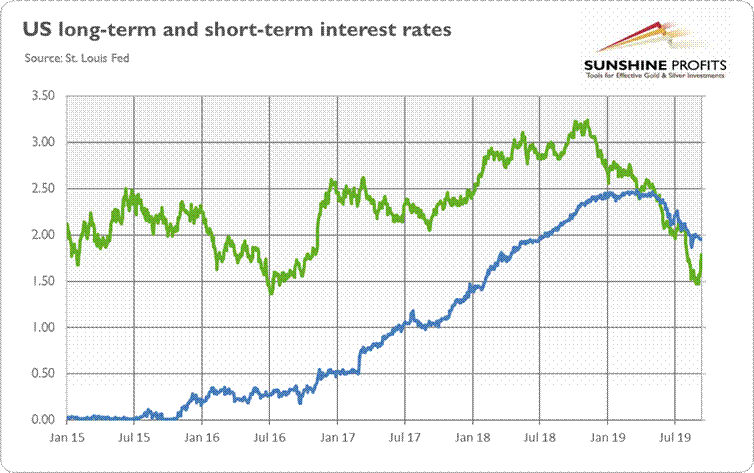The True Causes Behind the Yield Curve Inversion and Gold / Commodities / Gold & Silver 2019
 By now, everyone and their brother has heard aboutthe yield curve inversion. How come it has inverted and how much should we readinto it? Is it really such a reliable indicator of an upcoming recession? Let’sdig into the true causes behind the inversion and find out what its meaning forthe gold market.
By now, everyone and their brother has heard aboutthe yield curve inversion. How come it has inverted and how much should we readinto it? Is it really such a reliable indicator of an upcoming recession? Let’sdig into the true causes behind the inversion and find out what its meaning forthe gold market.
Is the yield curve inverted? Well, it depends. Although the spreadbetween the U.S. 10-year and 3-month Treasuries has normalized somewhat in September,it remained in negative territory. Meanwhile, after a short dip below zero inAugust, the spread between the U.S. 10-year and 2-year Treasuries spent time inpositive territory, as the chart below shows.
Chart1: Spread between US 10-year and 3-month Treasuries (blue line, daily numbers,in %) and spread between US 10-year and 2-year Treasuries (green line, dailynumbers, in %) from January 2019 to September 2019

Which spread should we trust? The literature saysthat the best results are obtained empirically by taking the difference betweentwo Treasury yields whose maturities are far apart. Using the three-monthTreasury rate (the overnight rate) at the short end is appropriate. When usedin combination with the ten-year Treasury rate to predict U.S. recessions, itprovides a reasonable combination of accuracy and robustness over long timeperiods. Thus, the U.S. yieldcurve has been inverted since mid-May, whichconstitutes a powerful recessionary signal. Indeed, that signal has beenrecently (at the turn of August and September) strengthened by the short-liveddive of the spread between 30-year Treasuries and 3-month below zero.
If history is any guide, we should expect arecession next year, possibly even before the presidential elections. Buy some gold, lots of popcorn, sit andwatch – it will be fun! Now, a very important thing: this scenario is notwritten in stone. History does not repeat itself, it only rhymes. So please beaware that the recession may came a bit earlier or later, or it may even decidenot to arrive. It would be unlikely, but we cannot exclude it. The yield curveis the most reliable recessionary indicator we have, but it’s not a crystalball, it’s just an indicator, man!
To use any indicatorwisely, we need to understand the broader context. We need more data and a proper background. Weneed to know the ultimate reasons behind the yield curve inversion. As one cansee in the chart below, although the U.S. long-term bond yields have decreased substantially since the end of2019, the main reason behind the yield curve inversion has been the steady rise in the short-term interest rates that started at the end of 2015.
Chart 2: US 10-year Treasury yields (green line)and US 3-month Treasury yields (blue line) from January 2015 to September 2019.

Now, the question is whether the short-term ratesclimbed because of the decrease in the supply of the U.S. government bonds ordue to increasing demand. Although the Fed has been engaged in some quantitative tightening, the unwinding of the U.S. central bank’s balance sheet started only in October 2017 and was rathermoderate. Moreover, the federal deficit has been growing since 2015, which means that theTreasury had to issue more bonds and notes to cover the gap between its revenueand spending. It means that the rise inthe short-term interest rates was caused by the more intense demand.
The key issue now is whatcaused that increase in demand.The Austrian theory of the business cycle is helpful here. At the beginning of the cycle,there is an artificial economic boom caused by the low interest rates andcredit expansion. Entrepreneurs take advantage of easy money and start manyprojects that wouldn’t be viable at higher rates. However, the competitionmakes the inputs more expensive. So, aswe approach the peak of the economic expansion, the input prices rises. Therising input prices squeeze profits margins, forcing entrepreneurs to seekshort-term financing to complete their business projects. In order to completethe projects, they are ready to borrow money at higher and higher rates. Asthey demand more funds, the yields, including the Treasury yields, increase.The rising prices also incite the Fed to hike the federal funds rate in order to curb inflation, adding to upward pressure on market interestrates.
What does it all mean? Well, we are approaching the end of the boom. The next phase is a bust. Nobodyknows when exactly it will come and how severe it will be. But it willarrive one day, and sooner rather than later. There shall be corporatebankruptcies then, weeping and gnashing of teeth. However, not for all thepeople. The bust is gold’s favoritephase, so those making the golden choice will thrive.
Thank you.
Ifyou enjoyed the above analysis and would you like to know more about the linkbetween the U.S. economy and the gold market, we invite you to read the August MarketOverview report. If you're interested in the detailed price analysis andprice projections with targets, we invite you to sign up for our Gold & SilverTrading Alerts . If you're not ready to subscribe at this time, we inviteyou to sign up for our goldnewsletter and stay up-to-date with our latest free articles. It's freeand you can unsubscribe anytime.
Arkadiusz Sieron
Sunshine Profits‘ MarketOverview Editor
Disclaimer
All essays, research and information found aboverepresent analyses and opinions of Przemyslaw Radomski, CFA and SunshineProfits' associates only. As such, it may prove wrong and be a subject tochange without notice. Opinions and analyses were based on data available toauthors of respective essays at the time of writing. Although the informationprovided above is based on careful research and sources that are believed to beaccurate, Przemyslaw Radomski, CFA and his associates do not guarantee theaccuracy or thoroughness of the data or information reported. The opinionspublished above are neither an offer nor a recommendation to purchase or sell anysecurities. Mr. Radomski is not a Registered Securities Advisor. By readingPrzemyslaw Radomski's, CFA reports you fully agree that he will not be heldresponsible or liable for any decisions you make regarding any informationprovided in these reports. Investing, trading and speculation in any financialmarkets may involve high risk of loss. Przemyslaw Radomski, CFA, SunshineProfits' employees and affiliates as well as members of their families may havea short or long position in any securities, including those mentioned in any ofthe reports or essays, and may make additional purchases and/or sales of thosesecurities without notice.
Arkadiusz Sieron Archive |
© 2005-2019 http://www.MarketOracle.co.uk - The Market Oracle is a FREE Daily Financial Markets Analysis & Forecasting online publication.
